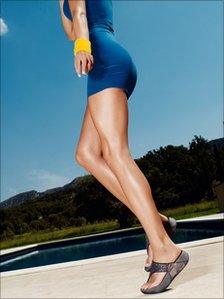Fitness flip-flops: What's behind this sandal fad?
- Published

Fitness flip-flops put a spring in your step, but your legs and bottom too?
A craze for flip-flops that supposedly help people lose weight and improve muscle tone has prompted Marks and Spencer to launch their own range. But is there evidence behind the fad?
It seems too good to be true. Footwear that started life on the beach has now been designed to help tone and trim your legs and bum every step you take.
High demand for the fitness flip-flops has prompted Marks and Spencer to jump on the bandwagon and launch its own version. It is the first High Street version, with a High Street price tag. But are they really an easy solution to toning up?
The original version, FitFlop, was launched in June 2007 and has sold over 10 million pairs. Sports footwear companies like Reebok soon followed suit and introduced their own ranges.
Makers say the sandals are designed to destabilise the foot slightly and force the legs to work harder by engaging muscles for a longer period of time with each step.
But there has been much discussion over the efficacy of the "gym in a shoe" everywhere from Facebook to the Mumsnet chat forum.
The company behind FitFlops points to its own research. It suggests the sandals help increase leg and bottom muscle activity by up to 30%, absorb more shock than a normal shoe (up to 22%) and help your joints. But while conducted by Salford University, the research was conducted on a sample of just 20 women. The company also points to 100-plus testimonials on its website.
Marks and Spencer says its own fitness flip-flops are based on independent research conducted by Dr Stefan Grau, an expert in biomechanics at the University of Tuebingen in Germany, one of Europe's leading sports science universities. While it was not conducted specifically for the retailer, Dr Grau has endorsed its new range.
According to the scientist, walking barefoot means the foot rolls more than in shoes, so wearing shoes which simulate this means the foot flexes more and in turn "works harder" and increases muscle activity. His study was based on 600 subjects.
Foot specialists say the fitness flip-flops are obviously better than the average flip-flop. This is because they are slightly elevated and are shock absorbent, says Michael O'Neill, consultant podiatrist at St Margaret's Hospital in Windsor and spokesman for the Society of Chiropodists and Podiatrists.
Raised heartbeat
But he adds that they are "the best of a bad bunch" and not as good for you as a pair of trainers. Those with conditions such as flat feet should avoid them completely, he adds.
Podiatrist Lorraine Jones says she sees a lot of injuries from people who wear flat shoes, like flip-flops. She agrees that compared with them, fitness fit-flops are good because of the cushioning and the strap over the foot could help control excessive motion in the mid-foot.
"If someone has excessive motion in the mid-foot that isn't controlled they could suffer tissue damage or heel or calf pain," she says.
But, she says she doesn't know anyone who has worn them who would say they have given them a "gorgeous bum or legs".
"It depends in which context you wear them. If it is a shortcut to getting a great bum and thighs, or if you are buying them with the aim of improving your muscle tone, then you are buying them for the wrong reasons.
"You might be better putting on a pair of trainers and striding out for a long walk, or getting on your bike. You have a better chance of toning up in a short space of time."
Chunky sole
The whole idea that fitness can be meaningfully promoted by footwear choice rather than lifestyle change is also questioned by some sports experts.
David Castle, editor of Running Fitness magazine, says fitness flip-flops are not going to give you the endorphin high of exercise - or the results.
"I don't doubt the claims, but people really shouldn't consider these shoes as an alternative to a proper run or gym workout.
Traditional flip-flops give the foot little support
"You are not going to get fit wearing a pair of flip-flops - not in the truest sense of the word. They aren't going to raise your heartbeat because they won't improve your aerobic fitness. If you wear a pair for four months and then try and run a marathon you are not going to have the fitness you need to run that marathon."
While the fit-flops may boast cutting edge technology, when it comes to the style stakes they get the thumbs down from some - despite having appeared in Vogue.
"They are the comfiest-ever sandal - think of wearing a sofa on your feet - but they can hardly be called cutting edge fashion," says Angela Kennedy, style director of Woman and Home magazine and reluctant fitness flip-flop fan.
"By virtue of their chunky sole they focus on creating a much heavier look on the feet which makes it really hard to balance out clothes wise.
"I love them for comfort and wear them when I'm on my feet all day on a hard studio floor, or walking long distances, but do find them hard to style up and have to think carefully about what to wear with them."